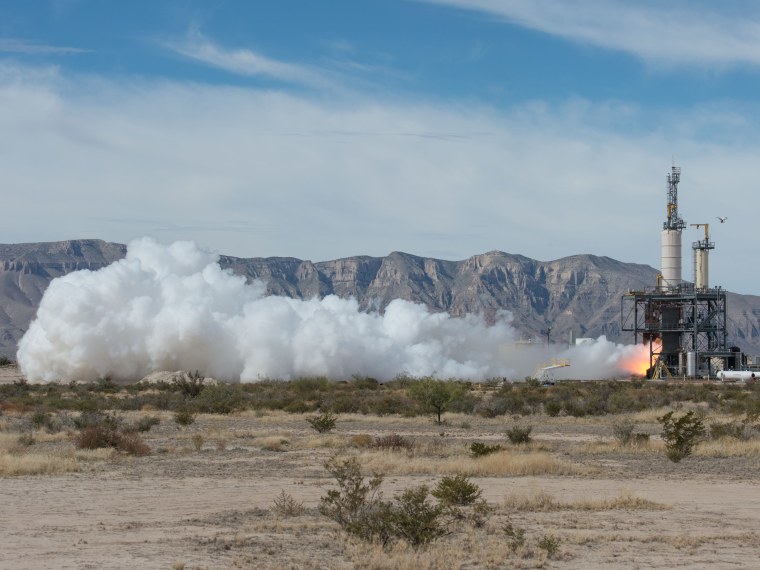Amazon founder Jeff Bezos' Blue Origin space venture said on Tuesday that it reached a key milestone in the development of its home-grown, hydrogen-fueled rocket engine.
Blue Origin fired its BE-3 engine on Nov. 20 for the full cycle that would be expected during a suborbital space journey — including a 145-second burn at 110,000 pounds of thrust, a four-minute shutdown, and then a restart at 25,000 pounds of thrust for a minute to simulate a controlled vertical landing.
"We intend to upgrade this engine for a variety of applications," the company's president, Rob Meyerson, told NBC News during Tuesday's teleconference.
For more than a decade, Blue Origin has been working on a launch system known as "New Shepard" that could send tourists and researchers on suborbital flights to the edge of space, more than 100 kilometers (62 miles) up. The company plans to leverage that technology into an orbital launch system capable of carrying astronauts to the International Space Station, starting sometime after 2018.
Engine strategy
The BE-3 engine is a key part of that strategy: It would be the first completely new engine developed in the United States to use liquid hydrogen in more than a decade, Meyerson said. Creating such an engine is difficult because it requires designing a machine that can operate at -423 degrees Fahrenheit (-253 degrees Celsius), the temperature of liquid hydrogen; and at more than 6,000 degrees F (3,300 degrees C), the engine temperature during firing. But Meyerson said liquid hydrogen was the best fuel option in terms of its performance.
“Given its high performance, low cost and reusability, the BE-3 is well-suited for boost, upper-stage and in-space applications on both government and commercial launch systems,” he said in a Blue Origin news release.
The engine was developed at Blue Origin's production center outside Seattle and tested at a facility nestled amid Bezos-owned ranchland in West Texas. To date, the BE-3 has demonstrated more than 160 starts and 9,100 seconds of operation, the company said.

NASA contributed to the effort under the terms of wider-ranging spaceship development contracts and through an unfunded Space Act Agreement to share expertise and test data. "Blue Origin has made steady progress since the start of our partnership under the first Commercial Crew Development round," Phil McAlister, NASA's director of commercial spaceflight development, said in an agency news release. "We're thrilled to see another successful BE-3 engine test fire."
Meyerson told reporters that NASA's help accelerated the BE-3 development program by more than a year. He declined to give a schedule for future development and flight testing, other than to say that Blue Origin was planning to start development of its orbital launch system in 2018 at NASA's Kennedy Space Center.
Launch pad battle
Blue Origin is vying with another commercial launch company, California-based SpaceX, for the use of Kennedy Space Center's Launch Complex 39A. NASA says it no longer needs that historic launch pad, which is where Apollo missions to the moon as well as the first and the last space shuttle missions blasted off. The agency wants to hand over maintenance and operation of 39A to a commercial entity as soon as possible — but Blue Origin has contested the procedure for choosing the operator. The Government Accountability Office is due to rule on Blue Origin's appeal by Dec. 12.
SpaceX says it could use 39A for a variety of commercial launches, including its current series of space station resupply missions. Blue Origin, meanwhile, has proposed turning the pad into a multi-user launch facility. In response, SpaceX founder Elon Musk told Space News in September that he'd be willing to let other launch providers use the pad even if his company won NASA's nod. He referred to Blue Origin specifically.
"If they do somehow show up in the next 5 years with a vehicle qualified to NASA’s human rating standards that can dock with the Space Station, which is what Pad 39A is meant to do, we will gladly accommodate their needs," Musk told Space News in an email. "Frankly, I think we are more likely to discover unicorns dancing in the flame duct.”
On Tuesday, Meyerson said he was still waiting to hear from the GAO. "We believe we've submitted a proposal that provides the fullest commercial use of the facility. ... If the outcome is that our proposal is not selected, we have many other options, and we would look at those other options," he said.
More about Blue Origin:
- Bezos in space? 'I definitely want to go,' billionaire says
- Billionaires' launch pad battle goes into overtime
- NBC News archive about Blue Origin
Alan Boyle is NBCNews.com's science editor. Connect with the Cosmic Log community by "liking" the log's Facebook page, following @b0yle on Twitter and adding the Cosmic Log page to your Google+ presence. To keep up with Cosmic Log as well as NBCNews.com's other stories about science and space, sign up for the Tech & Science newsletter, delivered to your email in-box every weekday. You can also check out "The Case for Pluto," my book about the controversial dwarf planet and the search for new worlds.
